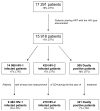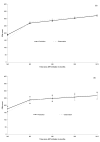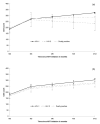First-year lymphocyte T CD4+ response to antiretroviral therapy according to the HIV type in the IeDEA West Africa collaboration
- PMID: 20397306
- PMCID: PMC2880184
- DOI: 10.1097/qad.0b013e3283377a06
First-year lymphocyte T CD4+ response to antiretroviral therapy according to the HIV type in the IeDEA West Africa collaboration
Abstract
Objective: To compare the lymphocyte T CD4+ (CD4) response to combinations of antiretroviral therapy (ART) in HIV-1, HIV-2 and dually positive patients in West Africa.
Design and setting: Collaboration of 12 prospective cohorts of HIV-infected adults followed in Senegal (2), Gambia (1), Mali (2), Benin (1) and Côte d'Ivoire (6).
Subjects: Nine thousand, four hundred and eighty-two patients infected by HIV-1 only, 270 by HIV-2 only and 321 dually positive, who initiated an ART.
Outcome measures: CD4 change over a 12-month period.
Results: Observed CD4 cell counts at treatment initiation were similar in the three groups [overall median 155, interquartile range (IQR) 68; 249 cells/microl). In HIV-1 patients, the most common ART regimen was two nucleoside reverse transcriptase inhibitors (NRTIs) and one non-nucleoside reverse transcriptase inhibitor (NNRTI; N = 7714) as well as for dually positive patients (N = 135). HIV-2 patients were most often treated with a protease inhibitor-based regimen (N = 193) but 45 of them were treated with an NNRTI-containing ART. In those treated with a NNRTI-containing regimen, the estimated mean CD4 change between 3 and 12 months was significantly lower in HIV-2 (-41 cells/microl per year) and dually positive patients (+12 cells/microl per year) compared to HIV-1 patients (+69 cells/microl per year, overall P value 0.01). The response in HIV-2 and dually positive patients treated by another regimen (triple NRTIs or protease inhibitor-containing ART) was not significantly different than the response obtained in HIV-1-only patients (all P values >0.30).
Conclusion: An optimal CD4 response to ART in West Africa requires determining HIV type prior to initiation of antiretroviral drugs. NNRTIs are the mainstay of first-line ART in West Africa but are not adapted to the treatment of HIV-2 and dually positive patients.
Figures




Similar articles
-
Characteristics of HIV-2 and HIV-1/HIV-2 Dually Seropositive Adults in West Africa Presenting for Care and Antiretroviral Therapy: The IeDEA-West Africa HIV-2 Cohort Study.PLoS One. 2013 Jun 18;8(6):e66135. doi: 10.1371/journal.pone.0066135. Print 2013. PLoS One. 2013. PMID: 23824279 Free PMC article.
-
Monitoring and switching of first-line antiretroviral therapy in adult treatment cohorts in sub-Saharan Africa: collaborative analysis.Lancet HIV. 2015 Jul;2(7):e271-8. doi: 10.1016/S2352-3018(15)00087-9. Epub 2015 Jun 16. Lancet HIV. 2015. PMID: 26423252 Free PMC article.
-
Immunologic response in treatment-naïve HIV-2-infected patients: the IeDEA West Africa cohort.J Int AIDS Soc. 2016 Feb 8;19(1):20044. doi: 10.7448/IAS.19.1.20044. eCollection 2016. J Int AIDS Soc. 2016. PMID: 26861115 Free PMC article.
-
Combination antiretroviral therapy without a nucleoside reverse transcriptase inhibitor: experience from 334 patients in three cohorts.HIV Med. 2007 Apr;8(3):171-80. doi: 10.1111/j.1468-1293.2007.00448.x. HIV Med. 2007. PMID: 17461861 Free PMC article.
-
Comparing HIV-1 and HIV-2 infection: Lessons for viral immunopathogenesis.Rev Med Virol. 2013 Jul;23(4):221-40. doi: 10.1002/rmv.1739. Epub 2013 Feb 26. Rev Med Virol. 2013. PMID: 23444290 Review.
Cited by
-
Antiretroviral Treatment of HIV-2 Infection: Available Drugs, Resistance Pathways, and Promising New Compounds.Int J Mol Sci. 2023 Mar 21;24(6):5905. doi: 10.3390/ijms24065905. Int J Mol Sci. 2023. PMID: 36982978 Free PMC article. Review.
-
Plasma HIV-2 RNA According to CD4 Count Strata among HIV-2-Infected Adults in the IeDEA West Africa Collaboration.PLoS One. 2015 Jun 25;10(6):e0129886. doi: 10.1371/journal.pone.0129886. eCollection 2015. PLoS One. 2015. PMID: 26111242 Free PMC article.
-
Antiretroviral therapy response among HIV-2 infected patients: a systematic review.BMC Infect Dis. 2014 Aug 26;14:461. doi: 10.1186/1471-2334-14-461. BMC Infect Dis. 2014. PMID: 25154616 Free PMC article.
-
Treatment outcomes and characteristics of HIV-2 patients compared to HIV-1 patients on an NNRTI-based first line art at the adult infectious diseases centre of the University Teaching Hospital (UTH) in Lusaka.Pan Afr Med J. 2021 Dec 16;40:231. doi: 10.11604/pamj.2021.40.231.25149. eCollection 2021. Pan Afr Med J. 2021. PMID: 35178142 Free PMC article.
-
Long-term immunological responses to treatment among HIV-2 patients in Côte d'Ivoire.BMC Infect Dis. 2020 Mar 12;20(1):213. doi: 10.1186/s12879-020-4927-x. BMC Infect Dis. 2020. PMID: 32164565 Free PMC article.
References
-
- World Health Organization Towards universal access: scaling up priority HIV/AIDS interventions in the health sector: progress report 2008. Geneva: 2008.
-
- van der Loeff MF, Awasana AA, Sarge-Njie R, van der Sande M, Jaye A, Sabally S, et al. Sixteen years of HIV surveillance in a West African research clinic reveals divergent epidemic trends of HIV-1 and HIV-2. International Journal of Epidemiology. 2006;35:1322–1328. - PubMed
-
- Eholie S, Anglaret X. Commentary: Decline of HIV-2 prevalence in West Africa: good news or bad news? International Journal of Epidemiology. 2006;35:1329–1330. - PubMed
-
- Valadas E, Franca L, Sousa S, Antunes F. 20 Years of HIV-2 Infection in Portugal: Trends and Changes in Epidemiology. Clinical Infectious Diseases. 2009;48:1166–1167. - PubMed
-
- Whittle H, Morris J, Todd J, Corrah T, Sabally S, Bangali J, et al. HIV-2-infected patients survive longer than HIV-1-infected patients. AIDS. 1994;8:1617–1620. - PubMed
Publication types
MeSH terms
Substances
Grants and funding
LinkOut - more resources
Full Text Sources
Medical
Research Materials

